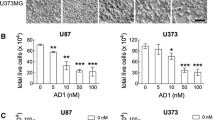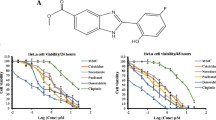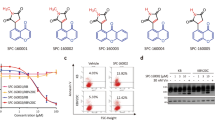Abstract
The drug effect of estramustine phosphate (EMP), an anti-microtubule agent on human glioma cells has been studied with the focus being mainly its cytotoxity or its targeting of organelles. However, the pharmacological knowledge of estramustine with respect to its cytotoxity and mechanism is limited. To acquire such knowledge, the present study investigates the ability of EMP to induce apoptosis in a human malignant glioma cell line. Transmission electron microscope (TEM) images were examined to monitor periodic changes. Agarose gel electrophoresis was also examined. Cellular DNA fragmentation ELISA was performed to investigate the DNA fragmentation rates and an MTT assay was studied to evaluate the ID50. A TEM study revealed condensing and fragmentation of the chromatin. Laddering of the bands was observed in all EMP exposure groups in agarose gel electrophoresis. DNA fragmentation in all EMP groups began at 0.5 h following an exposure with EMP and increased in a dose- and time-dependent manner as revealed by DNA ELISA fragmentation. ID50 at 24 h was 5.0 µM according to the MTT assay, a value close to 4.8 µM of ID50 was revealed by the DNA fragmentation assay. None of the above mentioned changes was observed in the control group. These results indicated that EMP caused a drug-induced apoptosis in the human malignant glioma cell line, U87MG.
Similar content being viewed by others
References
Sorger P, Dobles M, Tounebize R, Hyman A: Coupling cell division and cell death to microtubule dynamics. Curr Opin Cell Biol 9: 07-814, 1997
Yoshida D, Piepmeier JM, Teramoto A: In vitro inhibition of cell proliferation, viability, and invasiveness in U87MG human glioblastoma cells by estramustine phosphate. Neurosurgery 39: 360-366, 1996
Pittman S, Geyp M, Fraser M, Ellem K, Peaston A, Ireland A: Multiple centrosomal microtubule organising centres and inversed microtubule stability are early features of VP-16-induced apoptosis in CCRF-CEM cells. Leukem Res 21: 491-499, 1997
Weller M, Trepel M, Grimmel C, et al.: Hypericin-induced apoptosis of human malignant glioma cells is light-dependent, independent of bcl-2 expression, and does not require wild-type p53. Neurol Res 19: 459-470, 1997
Fisher D: Apoptosis in cancer therapy. Cell 78: 539-542, 1994
Jordan M, Toso R, Throewr D, Wison L: Mechanism of mitotic block and inhibition of cell proliferation by taxol at low concentrations. Proc Natl Acad Sci USA 90: 9552-9556, 1993
Jordan M, Wendell K, Gardner S, Derry W, Copp H, Wilson L: Mitotic block induced in HeLa cells by low concentrations of peclitaxol (Taxol) results in abnormal mitotic exit and apototic cell death. Cancer Res 56: 846-825, 1996
Lin CH, Forscher P: Cytoskeleton remodeling during growth cone-target interactions. J Cell Biol 121: 1369-1383, 1993
Woods C, Zhu J, MCQueney P, Bollag D, Lazarides E: Taxol-induced mitotic block triggers rapid onset of a p53-independent apoptotic pathway. Mol Med 1: 506-526, 1995
Vallbo C, Bergenheim A, Bergh A, Grankvist K, Henriksson R: DNA fragmentation induced by the antimitotic drug estramustine in malignant rat glioma but not in normal brain-suggesting an apoptotic cell death. Br J Cancer 71: 717-720, 1995
Bergenheim A, Henriksson R, Piepmeier J, Yoshida D: Estramustine in malignant glioma. J Neuro-Oncol 30: 81-89, 1996
Piepmeier J, Pedersen P, Yoshida D, Greer C: Targeting microtubule-associated proteins in glioblastoma: A new strategy for selective therapy. Ann Surg Oncol 3: 543-549, 1996
Bergenheim AT, Bjork P, Bergh J, von-Schoultz E, Svedberg H, Henriksson R: Estramustine-binding and specific binding protein of the anti-mitotic compound estramustine in astrocytoma. Cancer Res 54: 4974-4979, 1994
Forsgren B, Björk P: Specific binding of estramustine to prostatic proteins. J Urol 23: 31-38, 1984
Moraga D, Rivas-Berrios A, Farías G, Wallin M, Maccioni RB: Estramustine-phosphate binds to a tubulin binding domain on microtubule-associated proteins MAP-2 and tau. Biochem Biophys Acta 1121: 97-103, 1992
Sheridan VR, Speicher LA, Tew KD: The effects of estramustine on metaphase and anaphase in DU 145 prostatic carcinoma cells. Eur J Cell Biol 54: 268-276, 1991
Hartley-Asp B: Estramustine-induced mitotic arrest in two human prostatic carcinoma cell lines DU 145 and PC-3. The Prostate 5: 93-100, 1984
Kim JH, Khil MS, Ryu S, Gabel M: Clinical and biological studies of estramustine phosphate as a radiation sensitizer. Int J Radiat Oncol Biol Phys 29: 555-557, 1994
Ryu S, Gabel M, Khil MS, Lee YJ, Kim SH, Kim JH: Estramustine: A novel radiation enhancer in human carcinoma cells. Int J Radiat Oncol Biol Phys 30: 99-104, 1994
Yoshida D, Piepmeier JM, Weinstein M: Estramustine sensitizes human glioblastoma cells to irradiation. Cancer Res 54: 1415-1417, 1994
Yoshida D, Peipmeier J, Bergenheim A, Henriksson R, Teramoto A: Suppression of matrix metalloproteinase-2-mediated cell invasion in U87MG, human glioma cells by anti-microtubule agent: In vitro study. Br J Cancer 77: 21-25, 1998
Johansson M, Bergenheim A, D'Argy R, et al.: Distribution of estramustine in the BT4C rat glioma model. Cancer Chemother Pharmacol 41: 317-325, 1998
Hudes GR, Greenberg R, Krigel RL, et al.: Phase 2 study of Estramustine and Vinblastine, two microtubule inhibitors, in hormone-refractory prostate cancer. J Clin Oncol 10: 1754-1761, 1992
Burton K: A study of the conditions and mechanisms of the diphenylalamine reaction for the colorimetric estimation of deoxyribonucleic acid. Biochem J 62: 315-323, 1956
Gunnarsson PO, Andersson SB, Sandberg AA, Ellman M: Accumulation of estramustine and estromustine in adipose tissue of rats and humans. Cancer Chemother Pharmacol 28: 361-364, 1991
von-Shoultz E, Grankvist K, Gustavson H, Henriksson R: Effects of estramustine on DNA and cell membrane in malignant glioma cells. Acta Oncol 30: 719-723, 1991
Piepmeier JM, Keefe DL, Weinstein MA, et al.: Estramustine and estrone analogs rapidly and reversibly inhibit deoxyribonucleic acid synthesis and alter morphology in cultured human glioblastoma cells. Neurosurgery 32: 422-431, 1993
Bergenheim AT, Gunnarsson PO, Edman K, Schoultz EV, Hariz M: Uptake and retension of estramustine and presence of estramustine binding protein in malignant brain tumours in humans. Br J Cancer 67: 358-361, 1993
Rutberg M, Wallin M: Estramustine induces disorganization of microtubules, perinuclear retraction of vimentin and endoplasmatic reticulum, and inhibits cell migration. Acta Histochem 95: 155-167, 1993
Dahllof B, Billstrom A, Cabral F, Hartley-Asp B: Estramustine depolymerizes microtubules by binding to tubulin. Cancer Res 53: 4573-4581, 1993
Engstrom KG, Grankvist K, Henriksson R: Early morphological detection of estramustine cytotoxity measured as alteration in cell size and shape by a new technique of microperifusion. Eur J Cancer 27: 1288-1295, 1991
Yoshida D, Cornell-Bell A, Piepmeier JM: Selective antimitotic effects of estramustine correlate with its antimicrotubule properties on glioblastoma and astrocytes. Neurosurgery 34: 863-368, 1994
Stearns ME, Wang M, Sousa O: Evidence that estramustine binds MAP-1 A to inhibit type IV collagenase secretion. J Cell Sci 98: 55-63, 1991
von-Shoultz E, Begenheim T, Grankvist K, Henriksson R: Estramustine binding protein in human brain-tumor tissue. J Neurosurg 74: 962-964, 1991
Reed J: Regulation by Bcl-2 family proteins and its role in cancer and chemoresistance. Curr Opin Oncol 7: 541-546, 1995
Stewart B: Mechanisms of apoptosis' integration of genetic, biochemical and cellular factors. J Natl Cancer Inst 86: 1285-1295, 1994
Rieder C, Schultz A, Cole R, Sluder G: Anaphase onset in vertebrate somatic cells is controlled by a checkpoint that monitors sister kinetochore attachment to the spindle. J Cell Biol 127: 1301-1310, 1994
Author information
Authors and Affiliations
Rights and permissions
About this article
Cite this article
Yoshida, D., Hoshino, S., Shimura, T. et al. Drug-induced Apoptosis by Anti-microtubule Agent, Estramustine Phosphate on Human Malignant Glioma Cell Line, U87MG; in vitro Study. J Neurooncol 47, 133–140 (2000). https://doi.org/10.1023/A:1006393705560
Issue Date:
DOI: https://doi.org/10.1023/A:1006393705560




